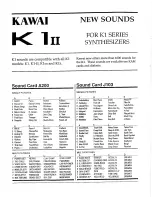
Control Features & Connections
6
M Manual
Control Feature
s & Connections
Front Panel
1) Display Section with encoders
4) Mixer Section
7) VCA, Glide & Master Volume
2) Wavetable Oscillator Section
5) Analog Filter Section (VCF)
8) Arpeggiator Section
3) LFO Section
6) Envelopes Section
9) Single/Multi Section
Summary of Contents for M
Page 1: ...User Manual ...





































